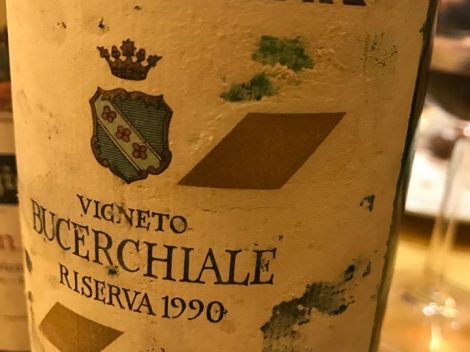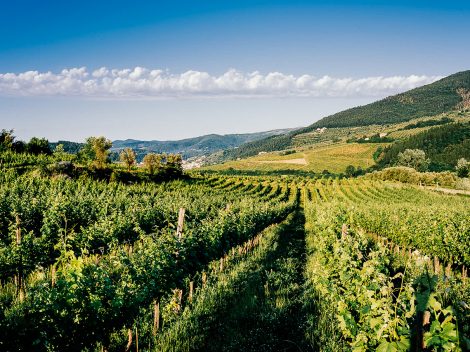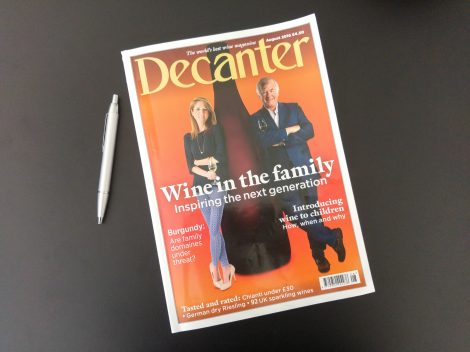Chianti
Courtney Scheissl recommended the 2015 Selvapiana Chianti Rufina
Courtney Scheissl, editor for VinePair recommended the 2015 Selvapiana Chianti Rufina in today’s post. Please see below for a link and the full article. SELVAPIANA CHIANTI RÙFINA 2015 My first and only trip to Chianti was a disaster. Mechanical issues, delayed flights, and endless rebooking lines delayed the arrival of an already short trip by almost a full day, landing me in a gray, rainy Florence shortly before sunset. I lamented the sights (and glasses of wine) that I was missing through the foggy, winding car trip into the heart of Chianti, which culminated in a stomach-upending climb into a hilltop village. Of course, the streets were too narrow to fit my taxi, leaving me to roll my mercifully small suitcase on uneven cobblestones solo. Clad in a day-old airplane outfit, I was exasperated and ready to turn around and head back to my cramped New York apartment. But as I reached the crest of the hill, the clouds parted to reveal a postcard-perfect sunset over the lush landscape, rainfall still clinging to the sprawling cypress trees. I took a deep breath of cool, damp evening air, and all my frustrations faded. That quiet, peaceful moment is exactly what the Selvapiana Chianti Rùfina 2015 evokes. With the exception of the traditional Chianti Classico zone, Chianti Rùfina is considered the most consistent and quality-driven subregion of Chianti. Cool breezes tend to create a style of wine with elegance and freshness, which the Selvapiana Chianti Rùfina certainly showcases. The aromas of this Sangiovese-based wine are fresh and cool, with notes of cranberries, cherry blossoms, basil, and turned earth, like a spring garden accented by morning dew. The palate leans toward the prettier side of Chianti, but it isn’t overly floral in any way. It’s clean and medium-bodied, just the kind of easy-drinking red that could easily find its way onto the Tuesday dinner table. But while it isn’t fussy, it isn’t a simple, throwaway wine either. And next to making the long and possibly exhausting trip to Tuscany, it’s the next best thing to being there. https://vinepair.com/good-wine-reviews/selvapiana-chianti-rufina-2015/
Shining a Light on Chianti Rufina
Chianti Classico is not the only Chianti. Just ask Federico Giuntini Masseti of the estate Fattoria Selvapiana. “In the wine world, the Chianti that is good and expensive for the consumer is the Chianti Classico,” he told me over lunch, as we sipped his exquisite and criminally underpriced single-vineyard Chianti Rufina called Vigneto Bucerchiale. “All the rest must be cheap, simple and you drink it when you are at university and you have no money.” There was a sly smile at the corner of his lips, but I’m sure the perception problem he was describing is not entirely a laughing matter. Continue reading on www.openingabottle.com
Tuscany by Vinum
The Tuscany dossier of Vinum magazine, with reviews of Chianti wines d.o.c.g. Chianti DOCG - Lagenweine mit Pepp
Liberty wines – Selvapiana 20 Years
Jancis Robinson Rewiew: A toast to Liberty Wines' David Gleave Selvapiana Vigneto Bucerchiale Chianti Rufina Riserva 2013, Chianti Rufina, Tuscany, Italy 17.5 points Pale fox red. Very sweet palate entry; you are really aware of the sunshine here! Transparency and considerable terroir effect. A real wine of place. Wonderfully long and tender. Vibrates. Selvapiana 2013 Pomino 17 points Dark and well-aged look. Rather Pomerol-like on the nose. Sweet and beautifully made with refined tannins but a little bite at the end – really lively! Like the perkiest claret imaginable. Good length.
Selvapiana Chianti Rufina 2015 Bruce Sanderson review
90 Points - 2015 Selvapiana Chianti Rufina DOCG Pure cherry aromas and flavors are enhanced by a smoky element in this juicy, round red. Hints of earth and mineral add interest on the finish. Drink now through 2023. 7,000 cases made. — Bruce Sanderson Selvapiana Chianti Rufina 2015 review from Wine Spectator
Latest Selvapiana July 2017 press clips
Attached please find all press from this past month: Wine Spectator - Selvapiana Fornace Wine Spectator - Selvapiana Chianti Rufina Vigneto Bucerchiale Riserva Wine Spectator -Selvapiana Tuscany
An old Rufina in perfect shape. By Luciano Pignataro Blogs
By Luciano Pignataro Blogs (http://www.lucianopignataro.it/a/toscana-1990-tre-chianti-casanova-neri/118941/). Toscana 1990: tre Chianti e il Casanova di Neri Ci si ritrova alla Galleria di Poggibonsi tra Giovani Igp. Qui Carlo Macchi ci trascina per farci mangiare mare in mezzo al Chianti prima di una epocale riunione di Garantito Igp con Stefano Tesi, Angelo Peretti, Andrea Petrini, Lorenzo Colombo e Roberto Giuliani. Da anni uno dei pochi segnali di aggregazione in web. Sarà per non siamo figli della rete ma delle reti. Fatto sta che non c’è niente di più bello che degustare vini in questo modo: Antichi Toscani dala cantina di Macchi raffreddato. Un atto di generosità enologica senza precedenti:-) Ci troviamo così questi quattro vini e ce li godimo tutti. Incredibile ma vero, a distanza di tanti anni quello che ci è piaciuto più di tutti è il Chianti Classico Riserva Selvapiana, un antico Rufina in perfetta forma, fresco, tonico, meraviglioso sul cino con ancora in serbo tante cose da regalare. Nonostante appartenga ad un’altra era geologica rispetto alla sua attuale evoluzione, paradossalmente il Casanova di Neri è invece quello che, pur affascinante e buono, è quello che ci ha rilassato di meno il palato. Troppo esuberante e materico per i Giovani Igp. A metà strada gli altri due, verso il Rufina il Ser Lapo di Castello di Fonterutoli. In direzione del Casanova di Neri il Monsanto del Poggio. Conclusioni Non siamo nei mitici anni ’80, ma sicuramente impressione bere questi rossi a distanza di tanti anni e vedere come hanno tenuto bene nel tempo. Note di frutta, freschezza, legno ben digerito come si diceva qualche anno fa, nessuna esasperazione per stupire inutilmente il palato. Spesso per godere il vino bisogna aspettarlo nel tempo. Ma la domanda finale è stata un po’ inquietante: quanti rossi del decennio successivo avranno questa capacità di affascinare chi li stappa? Ne parliamo tra 20 anni:-)
Excellent scores by Monica Larner of Wine Advocate/RobertParker.com for Selvapiana wines
Excellent scores by Monica Larner of Wine Advocate/RobertParker.com for Selvapiana wines in her article on the Chianti Rufina: Italy, Tuscany: Chianti Rufina (And Why the Region Should Consider a Name) Only a 30-minute drive northeast of Florence, Chianti Rufina is one of Italy’s most overlooked wine regions. Wild and rustic, Sangiovese vines (with other notable Tuscan grapes such as Trebbiano, Malvasia, Canaiolo and Colorino) are planted along the flanks of wooded hills with steep vertical drops and well-draining soils. Temperatures are a few degrees lower here on average compared to neighboring wine regions resulting in crisp and streamlined wines with delicate floral and berry nuances. The landscape is pristine and untouched. It recalls the best of Tuscany from a time before Tuscany was such a popular tourism destination. Despite its low profile, Chianti Rufina is indeed one of the oldest wine regions in Italy. Just a little while ago, it celebrated its 300th anniversary along with neighboring regions Chianti Classico, Pomino, Carmignano and Valdarno di Sopra. On September 24, 1716, the Granduca di Toscana Cosimo III drew the official lines that would set the lines for these storied appellations. Over the course of those three centuries, Chianti Rufina would emerge as one of the most productive wine hubs in Italy with a distribution network firmly in place across all major overseas markets. Its fortune would later decline and the region would become largely sidelined by the more prolific and sophisticated production power of Chianti Classico just next door. The Chianti Rufina appellation surrounds the historic railroad exchange at Pontassieve that once connected transportation lines between northern and southern Italy. Sangiovese-based wines were packaged in the iconic straw-wrapped flask, or fiasco, that would become a veritable symbol of Italian enology back when vino italiano was associated with easygoing, food-friendly wines to wash back with a plate of spaghetti and meatballs served on a checkered tablecloth at your favorite Italian-American trattoria. Millions of bottles were produced and distributed by rail across Europe and onto distant lands. Fruity, simple and acidic, the ruby-colored wine offered many Americans their first taste of Italian wine. In 1971, when the first super Tuscan wine Tignanello was produced by Piero Antinori, the hay-wrapped flask suddenly became a symbol of an old and outdated wine style. Chianti Rufina still has yet to fully recover from this image crisis, despite the impressive work and the important investments in the region today. On my tasting trip to Chianti Rufina during this special 300th anniversary year, I enjoyed the opportunity to exchange views with the producers and appellation officials. Our conversation focused on ideas that would help to re-launch and re-brand the region and distinguish it from Chianti Classico. How can Chianti Rufina get its groove back? This was the question on most people’s minds. Among the many ideas floated, one sticks out in my mind as an absolute no-brainer. There is a growing movement that favors changing the region’s name from Chianti Rufina to simply Rufina. It is my strong opinion that this easy name modification would bring many important benefits to the region. By shedding the name “Chianti,” the following objectives would be achieved: A more concrete identity for Rufina could be achieved by avoiding confusion with the Chianti Classico appellation and the larger denomination named Chianti. Rufina, Chianti Classico and Chianti would be viewed as three separate and independent wine regions. The name Rufina favors greater territorial identity. Rufina is a township in the province of Florence that includes the wine hub Pontassieve. Rufina is associated with a pristine and pure style of Sangiovese that stands apart from the denser and more extracted style of wine sometimes favored in Chianti Classico and elsewhere. The local blending formula reflects strict Tuscan traditions with other indigenous red and white grapes. Carmignano was once part of the greater Chianti region and was known as Chianti Carmignano. It changed its name from Chianti Carmignano to Carmignano and continues to enjoy the benefits of this change today. In other words, a successful model has already been set. Rufina could easily revive the celebrated hay-wrapped fiasco that was once at the heart of its international identity. If done with intelligence, Rufina could recreate this special indigenous packaging (that once required a cast of working women known as fiascaie to hand-assemble straw bottle exteriors) with the same stylistic ingenuity as the restyled Fiat 500 or the Vespa 50cc. I love the idea of a Rufina retro resurgence and I think consumers would, too. The bottom line is that Chianti Rufina’s wines are distinct from Chianti Classico, Chianti and the other appellations formally part of the greater Chianti territory in Tuscany. Its identity could be further developed with a simple name change. It seems to me that this would be a good place to start.
October 2016 Selvapiana tasting by jancisrobinson.com
October 2016 Selvapiana tasting by jancisrobinson.com: Selvapiana Located in Rufina, Selvapiana has been owned by the family of Francesco Giuntini since 1827. In medieval times, Selvapiana was one of the watch towers along the Sieve river, built to protect the city of Florence to the north-east border. During the Renaissance, it became a summer residence for noble families and Florentine bishops. Winemaker Francesco Giuntini, who was among the first Tuscan producers to make a Riserva wine from 100% Sangiovese, was born on the estate and now runs the property, with consultant Franco Bernabei. The estate covers 245 ha (605 acres), of which 54 are under vine and the rest olive groves and woods. The vineyards primarily face west, though Selvapiana's prized Bucerchiale vineyard is south-west facing. The vineyards are situated at an elevation of 150-200 m (492-656 ft), with a clay and limestone soil. Selvapiana 2014 Chianti Rufina - 16.5 Stelvin or cork. Light ruby with brick edges. Perfumed with sweet cherry fruit. Lively and with a fine chalky texture. Refined texture, chalky but compact. Dry but not in the least drying. Classic restraint. GV (JH)13% Drink 2016-2020 Selvapiana, Vigneto Bucerchiale Riserva 2012 Chianti Rufina - 16.5+ Single vineyard. Bricky garnet. Inviting mature undergrowth aroma but still with sweet, vanilla-edged red fruit. Very fragrant. A little meaty on the palate, some spice, fine grained though still with some firmness to the texture. Dry, chalky finish. (JH)14.5% Drink 2016-2022 Selvapiana, Villa di Petrognano 2012 Pomino - 16 Selvapiana rent 6 ha of vines from the Fattoria di Petrognano. Mid ruby. Plenty of spice here, tangy red and black fruit. Firm, chewy but lifted by very nice freshness. Straightforward but persistent. Just starting to show some mature, dried-fruit flavours on the finish. (JH) 14% Drink 2016-2019
Selvapiana Chianti Rufina 2014, first very good review from Decanter
Decanter August Issue Selvapiana Chianti Rufina 2016 Tasting by Michael Garner, Emily O'Hare, Monty Waldin.










